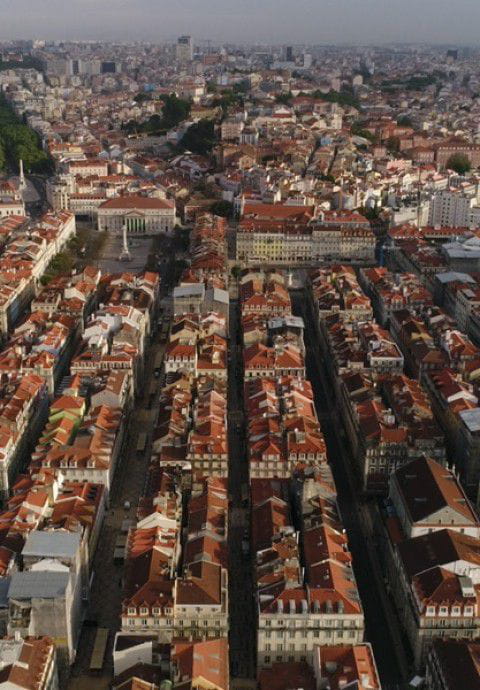

Did you know that the history and personality of modern Lisbon is the result of the effects of an earthquake? This week we will learn about the details of the Baixa Pombalina, the historic centre of Lisbon. Can you come with us?
It is estimated that 85% of the city's buildings were destroyed in the Baixa earthquake. Disaster was the starting point for a new city.
Baixa Pombalina: its history
On November 1, 1755, an earthquake of intensity nine, later accompanied by several tsunamis and devastating fires, destroyed the lower part of Lisbon.
The city administrators, led by Sebastião José de Carvalho e Melo, better known as the Marquis of Pombal, decided to rebuild Lisbon. This was the origin of the so-called Baixa Pombalina.
Pombal gave its name to urban reconstruction and planned a modern city, more functional and safer and with a new urban identity that left medieval Lisbon behind. Under rationalist and illustrated standards, the buildings of the Baixa are characterized by the uniformity of proportions and shapes.
Baixa Pombalina: its squares
The Baixa is the main meeting point to start our visit to Lisbon and an obligatory meeting point between Lisbon residents and tourists, with its lively bars and terraces and spacious squares. There are five large squares in the Baixa: Praça do Comércio, Praça Dom Pedro IV (Rossio), Praça dos Restauradores, Praça Figueira and Praça do Martim Moniz.
Lisbon is one of the few cities in the world that you can discover through its squares. Do you want to see it?
Praça do Comércio
Presided by the statue of Joseph I of Portugal, the king who was in command of the city during the earthquake. The Praça do Comércio was created just after the earthquake to replace the Royal Palace, destroyed in the incident and to build the ministries, and political institutions that should take control of the Portuguese empire. It also became the symbol of the revival of the city.
Also known as Terreiro do Paço, the Praça do Comércio can be considered, without a doubt, as the lung of the city. From here you can access on foot or by public transport to any of the areas of interest in Lisbon (Chiado, Belém, Alfama), or even the surroundings of the city (Sintra, Cascais, Estoril).
The southern end of the square is open and looks out onto the Tagus River. On the shore, from the Cais de Sodré river station, depart excursions along the Tagus, and other boats that cross the river to take you closer to different parts of the city.
On the opposite side, the Praça do Comércio ends at the Arco da Rua Augusta, crowned by a spectacular viewpoint. The arch was designed by the architect Santos de Carvalho to celebrate the reconstruction of the city after the major earthquake.
Do you want to start your visit by traveling through the history of Lisbon? An extraordinary option is to take a free tour Lisbon in the Praça do Comércio. Get information here. Choose the day and time and put yourself in the hands of our guides, who will guide you through the city on a free tour. Find our green umbrella!
Augusta Street and Praça do Rossio
Let's continue walking. From the square, we enter the Rua Augusta, a wide and bustling pedestrian street and one of the most famous commercial avenues in Portugal, which defines the axis of the Baixa urbanistically.
Here is located one of the many icons of the Portuguese capital, the Santa Justa viewpoint. It is an iron elevator inaugurated in 1902, in a neo-Gothic style and 45 meters high. Converted into a tourist attraction, its function was originally to connect the Baixa Pombalina with the Largo do Carmo, in the Chiado neighbourhood, at a higher altitude.
In the square we will be able to see some of the most outstanding monuments in Lisbon: the D. Maria II National Theatre and the Church of São Domingos in its surroundings, the crowning place of the former Portuguese monarchs, the Rossio railway station and the Café Nicola, one of the coffee temples in the city.
Praça da Figueira
A few meters away, we find the Praça da Figueira marked by classic buildings. You should take this square into account because you will find there one of the most atmospheric areas of the city, with numerous cafeterias, among which the centennial Confeitaria Nacional stands out.
In addition, Praça da Figueira concentrates several tram and bus stops, being one of the key transport hubs in Lisbon.
Praça dos Restauradores
This majestic square marks the boundary between the great Avenida da Liberdade and the Baixa. Named in honour of those who in 1640 rebelled against Spanish rule, it is chaired by an obelisk to commemorate this event.
A few meters away, you can access the Elevador da Gloria, which leads to the viewpoint of São Pedro de Alcântara in the Bairro Alto, one of the inescapable perspectives on your trip. It offers one of the best views of Lisbon.
Praça Martim Moniz and Fusion Market
Along with the previous one. It has a privileged location at the foot of the São Jorge Castle, becoming a leisure space in the centre of the city, housing the Fusion Market, a multicultural and gastronomic space with stalls of local and international cuisine.
The square is full of seats to sit down, to enjoy food and some of the leisure shows that are organized there daily, such as jazz concerts, open-air cinema, workshops or exhibitions.
[[TOUR_TLF]]
These are some attractions that mark the personality of Baixa Pombalina, the nerve centre of Lisbon. But if there is a city full of magic of its corners, this is Lisbon. We will be happy to offer you a new perspective.
Check here the Lisbon free tour and you will enjoy a different visit. Don’t lose it!
Travel with us!